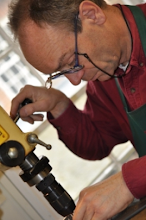I learned two things today.
I must show my clients in my written reports, which they get when I give them their repaired clocks back, how to set the time. Time setting on clocks can differ greatly between clocks. On some clocks you can happily (though gently please) push the minute hand past the half hour or hour—whichever comes first—without bending or breaking anything in the clock. On other clocks you can't. You will have to wait until the clock completes any striking before pushing the minute hand further.
On top of that, it turns out that some clients get into trouble during the switchover to winter time. For instance, on count wheel striking clocks, they push the hands backwards an hour and then discover that the hands are no longer in sync with the striking.
From now on, therefore, I would do well to add an Appendix to my reports explaining to the client how to set the time on their particular clock. This should help prevent getting clocks returned to me that are perfectly fine but for the striking being an hour ahead.
The second thing I learned today is that when you have put a complicated clock together and you notice that the bell hammer—in rest position—is not sitting perfectly between two pins on the pinwheel, then there may be a more efficient way of resolving this than taking the clock plates apart to adjust the pin wheel. I noticed that I could take the gathering pallet off the gathering pallet arbor, and
I must show my clients in my written reports, which they get when I give them their repaired clocks back, how to set the time. Time setting on clocks can differ greatly between clocks. On some clocks you can happily (though gently please) push the minute hand past the half hour or hour—whichever comes first—without bending or breaking anything in the clock. On other clocks you can't. You will have to wait until the clock completes any striking before pushing the minute hand further.
On top of that, it turns out that some clients get into trouble during the switchover to winter time. For instance, on count wheel striking clocks, they push the hands backwards an hour and then discover that the hands are no longer in sync with the striking.
From now on, therefore, I would do well to add an Appendix to my reports explaining to the client how to set the time on their particular clock. This should help prevent getting clocks returned to me that are perfectly fine but for the striking being an hour ahead.
The second thing I learned today is that when you have put a complicated clock together and you notice that the bell hammer—in rest position—is not sitting perfectly between two pins on the pinwheel, then there may be a more efficient way of resolving this than taking the clock plates apart to adjust the pin wheel. I noticed that I could take the gathering pallet off the gathering pallet arbor, and
- then put the pinwheel in the right position vis-à-vis the bell hammer, so that the bell hammer is exactly in the middle between two pins when the striking train is at rest position, while also ensuring that the warning pin on the warning wheel is in its stop position, and
- then put the gathering pallet back on its arbor also in rest or stop position.
That solved the problem nicely and efficiently in about one minute and with a lot less risk to any damage to the clock compared with taking plates apart and moving the pinwheel a few teeth.
